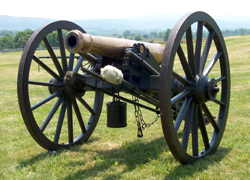|
Fort Ridgely And South Pass Wagon Road
The Fort Ridgely and South Pass Wagon Road (also known as Nobles Trail) was a wagon trail that was intended to connect Fort Ridgely in Minnesota Territory (now Minnesota) with South Pass in the Rocky Mountains of Nebraska Territory (now Wyoming). It was designed to link St. Paul with California via the Oregon Trail, however only a portion of the route was completed. The trail was promoted and supervised by William H. Nobles. Appropriations for the trail were authorized by the U.S. Congress on July 22, 1856. It was the first road built in Dakota Territory. The Fort Ridgely Road began in southwest Minnesota near present-day New Ulm and entered the Dakota Territory near Lake Benton. It crossed the Big Sioux River near Lake Campbell, continued south of Lake Thompson, and crossed the James River near present-day Forestburg before continuing on to the Missouri River south of Fort Lookout (near present-day Chamberlain). Only this portion, roughly 254 miles long, was built. From the ... [...More Info...] [...Related Items...] OR: [Wikipedia] [Google] [Baidu] |
Fort Ridgely
Fort Ridgely was a frontier United States Army outpost from 1851 to 1867, built 1853–1854 in Minnesota Territory. The Sioux called it Esa Tonka. It was located overlooking the Minnesota river southwest of Fairfax, Minnesota. Half of the fort's land was part of the south reservation in the Minnesota river valley for the Mdewakanton and Wahpekute tribes. Fort Ridgely had no defensive wall, palisade, or guard towers. The Army referred to the fort as the "New Post on the Upper Minnesota" until it was named for three Maryland Army Officers named Ridgely (Thomas, Randolph and Lott Henderson), who died during the Mexican–American War. History Construction The War Department hired Mr. Jessie H. Pomeroy of St. Paul to build both Fort Ridgely and Fort Ripley. At Ridgely there were two Companies of troops that assisted in quarrying the granite two miles away, transporting it to the site, and the erection of a 400-man stone barracks. The barracks formed the east side of the 90 ... [...More Info...] [...Related Items...] OR: [Wikipedia] [Google] [Baidu] |
Big Sioux River
The Big Sioux River is a tributary of the Missouri River in eastern South Dakota and northwestern Iowa in the United States. It flows generally southwardly for ,U.S. Geological Survey. National Hydrography Dataset high-resolution flowline dataThe National Map, accessed March 30, 2011 and its watershed is . The United States Board on Geographic Names settled on "Big Sioux River" as the stream's name in 1931. The river was named after the Lakota people (Sioux Natives) which was known by them as Tehankasandata, or Thick Wooded River. The Big Sioux River rises in Roberts County, South Dakota on a low plateau known as the Coteau des Prairies and flows generally southwardly through Grant, Codington, Hamlin, Brookings, Moody, and Minnehaha counties, past the communities of Watertown, Castlewood, Bruce, Flandreau, Egan, Trent, Dell Rapids, and Baltic to Sioux Falls, where it passes over a waterfall in Falls Park, which gives that city its name. Downstream of Sioux Falls and the c ... [...More Info...] [...Related Items...] OR: [Wikipedia] [Google] [Baidu] |
1850s Establishments In Minnesota Territory
Year 185 ( CLXXXV) was a common year starting on Friday (link will display the full calendar) of the Julian calendar. At the time, it was known as the Year of the Consulship of Lascivius and Atilius (or, less frequently, year 938 ''Ab urbe condita''). The denomination 185 for this year has been used since the early medieval period, when the Anno Domini calendar era became the prevalent method in Europe for naming years. Events By place Roman Empire * Nobles of Britain demand that Emperor Commodus rescind all power given to Tigidius Perennis, who is eventually executed. * Publius Helvius Pertinax is made governor of Britain and quells a mutiny of the British Roman legions who wanted him to become emperor. The disgruntled usurpers go on to attempt to assassinate the governor. * Tigidius Perennis, his family and many others are executed for conspiring against Commodus. * Commodus drains Rome's treasury to put on gladiatorial spectacles and confiscates property t ... [...More Info...] [...Related Items...] OR: [Wikipedia] [Google] [Baidu] |
Trails And Roads In The American Old West
A trail, also known as a path or track, is an unpaved lane or small road usually passing through a natural area. In the United Kingdom and the Republic of Ireland, a path or footpath is the preferred term for a pedestrian or hiking trail. The term is also applied in North America to routes along rivers, and sometimes to highways. In the US, the term was historically used for a route into or through wild territory used by explorers and migrants (e.g. the Oregon Trail). In the United States, "trace" is a synonym for trail, as in Natchez Trace. Some trails are dedicated only for walking, cycling, horse riding, snowshoeing or cross-country skiing, but not more than one use; others, as in the case of a bridleway in the UK, are multi-use and can be used by walkers, cyclists and equestrians alike. There are also unpaved trails used by dirt bikes and other off-road vehicles, and in some places, like the Alps, trails are used for moving cattle and other livestock. Usage In ... [...More Info...] [...Related Items...] OR: [Wikipedia] [Google] [Baidu] |

.jpg)